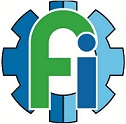Penentuan Pengaruh Jenis Insektisida pada Porositas Kertas Saring Menggunakan Analisa Image
Abstract
Abstract
Database of filter paper porosity in mosquito resistance test becomes significant in the quality parameter of mosquito resistance paper test. Insecticide has an important role in such paper. Some insecticide used in the resistance test was included in the porosity test. In order to find the porosity of WM filter paper with WHO standard, an imageJ application is needed to look for the volume of air-cavity. The paper used in this measurement was WM filter paper without insecticide as the control paper and WM filter paper with insecticide, namely cypermetrin, lamdacy halotrin, and permetrin with the concentrate that has been decided in the resistance test. The results of this study showed that the porosity of filter paper with 0,05% cypermetrin as the active insecticide was 41,53%, the porosity of filter paper with 0,03% lamdacy halotrin as the active insecticide was 49,37% and the porosity of filter paper with 0,25% permetrin as the active insecticide was 49,60%. Therefore, it was found out that based on its porosity, the filter paper with permetrin as the active insecticide was better.
Intisari
Database porositas kertas saring dalam uji resistensi nyamuk menjadi hal penting sebagai parameter kualitas kertas uji resistensi nyamuk. Insektisida mempunyai peranan penting dalam kertas tersebut. Beberapa insektisida yang dipakai dalam uji resistensi ikut dalam uji porositas. Untuk menemukan porositas pada kertas saring WM berstandar WHO diperlukan aplikasi imageJ dalam mencari volume rongga udara. Kertas yang digunakan dalam pengukuran ini adalah kertas saring WM tanpa insektisida sebagai kertas kontrol dan kertas saring WM berinsektisida, yaitu cypermetrin, lamdacy halotrin, dan permetrin dengan konsentrasi yang telah ditetapkan dalam uji resistensi. Hasil dari penelitian menunjukkan bahwa kertas saring dengan campuran bahan aktif insektisida jenis cypermetrin 0,05% memiliki porositas sebesar 41,53%, kertas yang bercampur dengan bahan aktif insektisida jenis lamdacy halotrin 0,03% memiliki porositas sebesar 49,37% dan kertas yang bercampur dengan bahan aktif insektisida jenis permetrin 0,25% memiliki porositas sebesar 49,60%. Sehingga didapatkan bahwa untuk kertas saring dengan bahan aktif insektisida permetrin lebih baik dilihat dari porositasnya.
Keywords
Full Text:
PDFReferences
D. Kartika dan W. Hafid, “Studi Pelaksanaan Program Fogging Pada Penanggulangan DBD Di Wilayah Kerja Dinas Kesehatan Bone Bolang,” Glob. Health Sci., vol. 2, no. 3, Sep 2017.
T. Krianto, “Masyarakat Depok Memilih Fogging yang Tidak Dimengerti,” J. Kesehat. Masy. Nas., vol. 4, no. 1, Agu 2009.
Ambarwati, S. Darnoto, dan D. Astuti, “Fogging Sebagai Upaya Untuk Memberantas Nyamuk Penyebar Demam Berdarah Di Dukuh Tuak Desa Gonilan, Kartasura, Sukoharjo,” WARTA, vol. 9, no. 2, hlm. 130–138, Sep 2006.
L. Susanti dan H. Boesri, “Insektisida Sipermethrin 100 G/L Terhadap Nyamuk Dengan Metode Pengasapan,” KEMAS, vol. 7, no. 2, Jan 2012.
S. D. Lesmana, “Resistensi Aedes aegypti terhadap Insektisida Golongan Organofosfat,” JIK, no. 1, hlm. 10–13, Mar 2010.
M. Raini, “Toksikologi Insektisida Rumah Tangga dan Pencegahan Keracunan,” Media Penelit. Dan Pengemb. Kesehat., vol. XIX, 2009.
R. Setiyaningsih, “Pengembangan Impregnated Paper Untuk Evaluasi Penggunaan Insektisida (Cypermetrin, Permetrin Dan Lamdacyhalotrin)Terhadap Nyamuk Aedes Aegypti. B2P2VRP Salatiga.,” 2016.
R. Setiyaningsih, “Uji Efikasi Dan Stabilitas Impregnated Paper Produk Lokal Dengan Bahan Aktif Insektisida Cypermetrin, Permetrin Dan Lambdacyhalotrin Terhadap Nyamuk Aedes aegypti. B2P2VRP Salatiga,” 2017.
S. F. Dina, N. Elyani, H. Rozikin, dan L. Kusumawati, “Biorefining Sebagai Salah Satu TeknologiAlternatif Pada Proses Penggilingan Serat,” J. SELULOSA, vol. 42, no. 01, hlm. 1–7, Jun 2007.
C. Grove dan D. A. Jerram, “jPOR: An ImageJ Macro to Quantify Total Optical Porosity From Blue-Stained Thin Sections,” Comput. Geosci., vol. 32, hlm. 1850–1859, 2011.
N. H. Astuti, N. A. Wibowo, dan M. R. S. S. N. Ayub, “The Porosity Calculation Of Various Types Of Paper Using Image Analysis,” J. Pendidik. Fis. Indones., vol. 14, no. 1, hlm. 46–51, Jan 2018.
H. Setiawan, M. R. S. Shanti, A. Pattiserlihun, dan R. Setiyaningsih, “Perhitungan Porositas Pada Impregnated Paper Produk Lokal Dengan Bahan Aktif Insektisida,” Pros. UNNES, 2017.
D. . Sulistyaningsih, M. R. S. Shanti, R. Setiyaningsih, dan J. Muninggar, “Perhitungan Penyusutan Rongga Udara Pada Serat Kertas Yang Tervariasi Cairan,” Pros. IConsee FSM UKSW, 2017.
C. Kurniawan, T. B. Waluyo, dan P. Sebayang, “Analisis Ukuran Partikel Menggunakan Free Software IMAGE - J,” Pus. Penelit. Fis. - LIPI, Jul 2011.
Gunawan, F. Halim, dan E. Wijaya, “Perangkat Lunak Segmentasi Citra dengan Metode Watershed,” JSIFO, vol. 12, Okt 2011.
L. Reinking, “Examples of Image Analysis Using ImageJ.” Jun-2007.
L. Reinking, “ImageJ Basics (Version 1.38).” Jun-2007.
M. Haeri dan M. Haeri, “ImageJ Plugin for Analysis of Porous Scaffolds used in Tissue Engineering,” Open Res. Softw., 2015.
DOI: http://dx.doi.org/10.12962/j24604682.v15i2.4270
Refbacks
- There are currently no refbacks.

This work is licensed under a Creative Commons Attribution-ShareAlike 4.0 International License.







